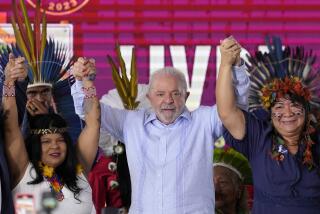Briefing Paper : Albania--A Step to Democracy
- Share via
The News:
Albanians vote next Sunday, March 31, in the tiny Balkan nation’s first-ever multi-party election after half a century of totalitarian rule that was the most repressive and inflexible in Eastern Europe.
What’s at Stake:
Long isolated by the authoritarian rule of late Stalinist dictator Enver Hoxha, Albanians have suddenly found themselves in the unfamiliar position of having a say in the policies and personalities of their government. The country that was hermetically sealed off from the rest of the world until last year remains deeply influenced by the Communist ideology that is the only guiding force the public has known for generations. Access to telephones, transport, the mass media and other tools of influence are still firmly under the control of the ruling Albanian Party of Labor--the Communists. What will be tested on Sunday is whether the nascent fever for democracy is strong enough to overcome the ruling party’s colossal advantage.
The Background:
A nation of more than 3.2 million, Albania has been ruled by devout Stalinists since Hoxha and his partisans liberated the country from fascism at the end of World War II. Hoxha died in April, 1985, but the personality cult he built during 40 years of absolute power was never shaken until pro-democracy demonstrators rose up in 1990 to challenge his successor, President Ramiz Alia.
Despite a proliferation of newly formed political parties, the real battle will be between the Communists and the Democratic Party, the main opposition group formed by students and intellectuals last December. There are 1,074 candidates running in 250 voting districts, each of which will send a delegate to the People’s Assembly. The parliamentary body will then elect a new president and adopt a democratic constitution to replace the Communist-drafted blueprint.
The Players:
* Albanian Party of Labor--The Communists are headed by 65-year-old President Alia. Hoxha’s handpicked successor kept Albania in isolation until the spread of anti-Communist revolution throughout Eastern Europe combined with economic devastation to stir social unrest. Alia broke with Hoxha’s pledge of independence at any price last spring, announcing modest reforms that opened the door to a mass exodus of the discontented, and mounting social pressure for democracy. Hoxha’s widow and ideological torch-bearer, Nexmija, has been campaigning vigorously in Communist strongholds of the south for retention of the hard line he espoused for 40 years and for protection of his embattled image.
* Democratic Party--Under the leadership of 45-year-old Sali Berisha, the Democrats have amassed a considerable following in the bare three months since Albania’s first opposition party was allowed to form as a concession to massive pro-democracy demonstrations. A cardiologist who eschews the Communists’ stuffy formality in favor of open collars and a Burberry trench coat, Berisha has skills of oratory and organization that quickly propelled him to broad respect in a society deeply divided between a privileged elite and impoverished masses.
* Republican Party--The second-biggest opposition group, the Republicans are seen as a repackaged spinoff from the Communists and would likely join forces with the dominant party to form a governing coalition. The new party is led by Sabri Godo, a writer and former journalist for the official newspaper Zeri i Popullit. Despite close ties to the Communists, Godo sees his party as heir to the politics of Fan Noli, the Harvard-educated bishop who served as prime minister during Albania’s brief attempt at parliamentary democracy in the early 1920s.
* Democratic Front--Closely allied with the Communists, the new opposition party is headed by former Prime Minister Adil Carcani, a loyal disciple of Hoxha who is expected to resist deep-running reforms that would violate basic tenets of orthodox communism.
Other parties with a chance of winning parliamentary representation are the environmentalist Greens party, the pro-Communist Agrarian Party, the Albanian Women’s Committee and the Greek-minority Omania organization.
Scenarios:
Some possibilities for the election:
* Indoctrinated by decades of one-party propaganda, Albanians return the Communists to power, hoping to regain control over the tumult of change rocking their country. Even in the event of a Communist landslide, some opposition figures are likely to win seats and continue to challenge the political force that will increasingly be seen as responsible for bringing about the country’s demise.
* Confused by the plethora of choice, Albanians split their vote among the main parties, forcing a coalition between the Communist group and the several new offshoots that remain loyal to its doctrine.
* The hunger for change and freedom exceeds the most optimistic expectations, and a majority of voters backs the Democratic Party, setting Albania on a course toward market reforms and alliance with the West. The last and toughest Communist domino of Eastern Europe finally topples.
Polling Place
Albania at a Glance
* Population: 3.2 million. Life expectancy at birth, 72 years. Literacy rate: 75%. Suffrage: universal and compulsory at age 18.
* Geography: At 11,000 square miles, Albania is slightly larger than the state of Maryland.
* Natural resources: crude oil, natural gas, coal, chromium, copper, timber and nickel.
* Economy: GNP is estimated at $3.8 billion, per capita $1,200. Industries include chemical fertilizer and textiles. Chief crops are corn, wheat, cotton, potatoes, tobacco and citrus fruits. Labor force is 50% agricultural and 50% industrial and commercial.
* Government: Communist. The People’s Assembly, a single-chamber legislature of 250 deputies, meets a few days a years, essentially to ratify actions taken in its name by the chairman of the Assembly, Ramiz Alia.
Sources: World Almanac, 1991; World Factbook, 1990.
More to Read
Sign up for Essential California
The most important California stories and recommendations in your inbox every morning.
You may occasionally receive promotional content from the Los Angeles Times.













